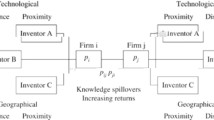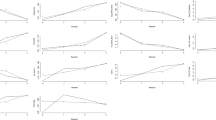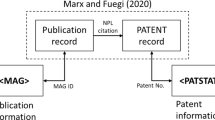Abstract
This paper uses citations to university-issued patents to investigate the knowledge flow from 91 US research universities to businesses assigned to 142 US cities or metropolitan areas (MSAs) from which they filed their patent applications. The citation of university patents depends on the various types of separation between the universities (origin) and businesses (destination) measured by distance, technological compatibility, and the presence of a state or local border. The analysis also accounts for university and citing region fixed effects. We use these to report original measures of the ability of universities to diffuse knowledge and the capacity of firms in MSAs to absorb university knowledge. We find that citations to university patents are significantly higher for universities in the same location as the citing firms, and the same location effect is greater for public than private universities. The distance indicator variables show that citations at distances beyond 50 miles are not different from citations beyond 2000 miles. Technological compatibility of university and industry patents has a large impact on university patent citations and exhibits considerably variation across university–MSA/city pairs. MIT has the largest fixed effect (diffusion) estimate, and its value is more than twice the diffusion estimate of Stanford, the university with the second highest value. The academic quality of universities and characteristics of their technology transfer office are found to positively impact the ability of universities to diffuse knowledge.



Similar content being viewed by others
Notes
The spatial interaction model differs from the matching method in two ways. The use of technology compatibility between the two locations is analogous to controlling for the distribution of technological activities in the choice-sampling method. First, compared to the matching method, it avoids selecting a control group of technologically similar patents. Selection of a control group has been challenged by Thompson and Fox-Kean (2005) and Murata et al. (2014). Second, the focus in the spatial interaction model is on the interaction patterns at the aggregate level rather than the individual level as in the choice-sampling approach.
The current research investigates university knowledge transfer measured by patent-to-patent citations. Important information is also contained in the paper-to-patent citations, the non-patent citations on the patent application. The data on citations to university research papers in the patent applications filed by firms and individuals is not available in the NBER patent database. Roach and Cohen (2013) investigate patent-to-patent and paper-to-patent citations from universities to 676 research labs in the Carnegie Mellon Study. Extensive effort was required to obtain information for non-patent references. They conclude that while patent citations do not reflect knowledge flows through other channels such a faculty consulting and faculty research papers, they do represent an important channel of knowledge flow from university to firms. Belenzon and Schankerman (2013) trace knowledge spillover using patent citations to university scientific publications. The results show rapid decay with distance and a positive state border effect, similar to the patent-to-patent results. An advantage of the patent-to-patent analysis is that a technology match is available to use as a control variable.
Mowery and Ziedonis (2015) restrict their analysis of university citation flow to the 50 largest MSAs.
The calculation of the compatibility index is as follows. A matrix is constructed for the 36 citing technology classes based on the share of citations to existing patents in each of the 36 technology classes to total cited patents granted between 1990 and 1999. The shares are correlated with the shares of patents in each of the 36 classes to total patents granted to each university. To measure the compatibility between MSAs i and university j requires the concentration of patents of university j. The compatibility index between MSA i and university j is given by the correlation between MSA i’s correlation with the patent citation matrix and the share of university j’s distribution of patents in the 36 technology classes.
While Table 4 shows that the city with which a university shares the highest technological compatibility is over 1000 miles away, in general universities are more technologically compatible with their own cities than with all other cities. Like Belenzon and Schankerman (2013), these observations cast doubt on the issue of endogeneity of firm location decisions. If any evidence of strong local knowledge spillovers is the result of firms choosing to locate next to universities with which they have strong innovation ties and not an indicator of localized knowledge spillover, the highest compatibility is unlikely to be found with universities over a thousand miles away.
As a consequence of the nature of the regression equation in Eq. (2), a one-unit increase in an independent variable implies a regression coefficient \(\beta = ln(c_{ij,2}) - ln(c_{ij,1})\), where \(c_{ij,1}\) is the value of the dependent variable before a one-unit increase in an explanatory variable and \(c_{ij,2}\) is its value after the change. Since the difference in the logarithms is the same as the logarithm of the ratios of the dependent variable after and before the change, the ratio of the dependent variable equals \(e^\beta\). The incidence rate ratios reported in Table 8 reflect these \(e^\beta\) values.
Virginia Commonwealth was the excluded university for the fixed effects analysis and thereby had a value of 1. The other five universities have fixed effects less than 1.
The number of observations, 69, is less than the universities in the knowledge flow model, 91, due to the University of California system responding the AUTM survey rather than individual campuses and some universities in our sample did not respond to the AUTM survey.
References
Anderson, T. R., Daim, T. U., & Lavoie, F. F. (2007). Measuring the efficiency of university technology transfer. Technovation, 27, 306–318.
Association of University Technology Managers (AUTM). (1999). The AUTM licensing survey. Technical Report, Association of University Technology Managers.
Astebro, T. B., & Bazzazain, N. (2011). Universities, entrepreneurship and local economic development. In M. Fritsch (Ed.), Handbook of Research on entrepreneurship and regional economic development (pp. 252–333). Cheltenham: Edward Elgar Publishing.
Belenzon, S., & Schankerman, M. (2013). Spreading the word: Geography, policy, and knowledge spillovers. The Review of Economics and Statistics, 95(3), 884–903.
Berbegal-Mirabent, J., Lafuente, E., & Sole, F. (2013). The pursuit of knowledge transfer activities: An efficiency analysis of Spanish universities. Journal of Business Research, 66, 2051–2059.
Bozeman, B., Fay, D., & Slade, C. P. (2013). Research collaboration in universities and academic entrepreneurship: The-state-of-the-art. Journal of Technology Transfer, 38, 1–67.
Fischer, M. M., Scherngell, T., & Jansenberger, E. (2009). Geographic localisation of knowledge spillovers: Evidence from high-tech patent citations in Europe. Annals of Regional Science, 43, 839–858.
Griffith, R., Lee, S., & Reenen, J. (2007). Is distance dying at last? Falling home bias in fixed effects models of patent citations. Cambridge, MA: National Bureau of Economic Research.
Griliches, Z. (1990). Patent statistics as economic indicators: A survey. Journal of Economic Literature, 28(4), 1661–1708.
Hall, B., Jaffe, A., & Trajtenberg, M. (2001). The NBER patent citation data file: Lessons, insights and methodological tools. NBER Working Paper No. 8498.
Harhoff, D., Narin, F., Scherer, F. M., & Vopel, K. (1999). Citation frequency and the value of patented inventions. The Review of Economics and Statistics, 81(3), 511–515.
Hussler, C. (2004). Culture and knowledge spillovers in Europe: New perspectives for innovation and convergence policies? Economics of Innovation and New Technology, 13(6), 523–541.
Jaffe, A., Trajtenber, M., & Fogarty, M. (2000). Knowledge spillovers and patent citations: Evidence from a survey of inventors. American Economic Review, 90(May), 215–218.
Jaffe, A., Trajtenber, M., & Henderson, R. (1993). Geographic localization of knowledge spillovers as evidenced by patent citations. Quarterly Journal of Economics, 108(3), 577–598.
Kim, Y. (2013). The ivory tower approach to entrepreneurial linkage: Productivity changes in university technology transfer. Journal of Technology Transfer, 38, 180–197.
Laursen, K., & Salter, A. (2004). Searching high and low: What Types of firms use universities as a source of innovation? Research Policy, 33, 1201–1215.
LeSage, J. P., & Fischer, M. M. (2010). Spatial econometric methods for modeling origin–destination flows. In M. M. Fischer & A. Getis (Eds.), Handbook of applied spatial analysis: Software tools, methods and applications. Berlin: Springer.
LeSage, J. P., Fischer, M. M., & Scherngell, T. (2007). Knowledge spillovers across Europe: Evidence from a Poisson spatial internation model with spatial effects. Papers in Regional Science, 86(3), 393–421.
LeSage, J. P., & Llano, C. (2013). A spatial interaction model with spatially structured origin and destination effects. Journal of Geographic Systems, 15, 265–289.
LeSage, J. P., & Pace, R. K. (2008). Spatial econometric modeling of origin–destination flows. Journal of Regional Science, 48(6), 941–967.
Li, Y. (2014). Borders and distance in knowledge spillovers: Dying over time or dying with age?—Evidence from patent citations. European Economic Review, 71, 152–172.
Maurseth, P. B., & Verspagen, B. (2002). Knowledge spillovers in Europe: A patent citation analysis. Scandinavian Journal of Economics, 104(4), 531–545.
Mowery, D. C., & Ziedonis, A. A. (2015). Markets versus spillovers in outflows of university research. Research Policy, 44, 50–66.
Mukherji, N., & Silberman, J. (2013). Absorptive capacity, knowledge flows, and innovation in U.S. metropolitan areas. Journal of Regional Science, 53(3), 392–417.
Mukherji, N., & Silberman, J. (2018). Knowledge flow among U.S. metro areas: Innovative activity, proximity, and the border effect. Review of Regional Studies, 48, 193–216.
Murata, Y., Nakajima, R., Okamota, R., & Tamura, R. (2014). Localized knowledge spillovers and patent citations: A distance-based approach. The Review of Economics and Statistics, 96(5), 967–985.
National Research Council. (1993). National survey of graduate faculty. Technical Report 1993.
Peri, G. (2005). Determinants of knowledge flows and their effect on innovation. The Review of Economics and Statistics, 87(2), 308–322.
Phan, P. H., & Siegel, D. S. (2006). The effectiveness of university technology transfer. Foundations and Trends in Entrepreneurship, 2(2), 77–144.
Roach, M., & Cohen, W. (2013). Lens or prism? Patent citations as a measure of knowledge flows from public research. Management Science, 59(2), 504–525.
Scherngell, T., & Barber, M. J. (2011). Distinct spatial characteristics of industrial and public research collaborations: Evidence from the fifth EU framework programme. Annals of Regional Science, 46, 246–266.
Siegel, D., Waldman, D., & Link, A. (2003). Assessing the impact of organizational practices on the relative productivity of university technology transfer offices: An exploratory study. Research Policy, 32(1), 27–48.
Siegel, D. S., & Wright, M. (2015). University technology transfer offices, licensing, and startups. In D. S. Siegel, A. N. Link, & M. Wright (Eds.), Chicago handbook of university technology transfer and academic entrepreneurship (pp. 1–40). Chicago, IL: University of Chicago Press.
Singh, J., Marx, M., & Fleming, L. (2010). Patent citations and the geography of knowledge spillovers: Disentangling the role of state borders, metropolitan boundaries and distance. Fountainebleau, France: INSEAD Working Paper Series.
Thompson, P., & Fox-Kean, M. (2005). Patent citations and the geography of knowledge spillovers: A reassessment. American Economic Review, 95(1), 450–460.
Thursby, J. G., & Kemp, S. (2002). Growth and productive efficiency of university intellectual property licensing. Research Policy, 31(1), 109–124.
Acknowledgements
We thank the referees and the editor for comments that greatly improved the manuscript.
Author information
Authors and Affiliations
Corresponding author
Additional information
Publisher's Note
Springer Nature remains neutral with regard to jurisdictional claims in published maps and institutional affiliations.
Electronic supplementary material
Below is the link to the electronic supplementary material.
Rights and permissions
About this article
Cite this article
Mukherji, N., Silberman, J. Knowledge flows between universities and industry: the impact of distance, technological compatibility, and the ability to diffuse knowledge. J Technol Transf 46, 223–257 (2021). https://doi.org/10.1007/s10961-019-09770-9
Published:
Issue Date:
DOI: https://doi.org/10.1007/s10961-019-09770-9




